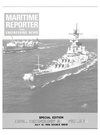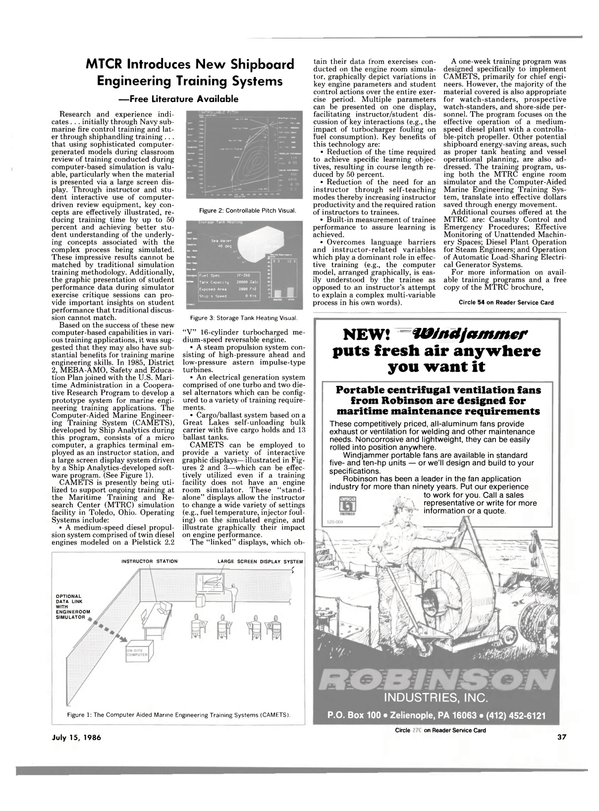
MTCR Introduces N e w Shipboard E n g i n e e r i n g T r a i n i n g Systems
— F r e e Literature Available Research and experience indicates . . . initially through Navy submarine fire control training and later through shiphandling training . . .
that using sophisticated computergenerated models during classroom review of training conducted during computer-based simulation is valuable, particularly when the material is presented via a large screen display.
Through instructor and student interactive use of computerdriven review equipment, key concepts are effectively illustrated, reducing training time by up to 50 percent and achieving better student understanding of the underlying concepts associated with the complex process being simulated.
These impressive results cannot be matched by traditional simulation training methodology. Additionally, the graphic presentation of student performance data during simulator exercise critique sessions can provide important insights on student performance that traditional discussion cannot match.
Based on the success of these new computer-based capabilities in various training applications, it was suggested that they may also have substantial benefits for training marine engineering skills. In 1985, District 2, MEBA-AMO, Safety and Education Plan joined with the U.S. Maritime Administration in a Cooperative Research Program to develop a prototype system for marine engineering training applications. The Computer-Aided Marine Engineering Training System (CAMETS), developed by Ship Analytics during this program, consists of a micro computer, a graphics terminal employed as an instructor station, and a large screen display system driven by a Ship Analytics-developed software program. (See Figure 1).
CAMETS is presently being utilized to support ongoing training at the Maritime Training and Research Center (MTRC) simulation facility in Toledo, Ohio. Operating Systems include: • A medium-speed diesel propulsion system comprised of twin diesel engines modeled on a Pielstick 2.2 "V" 16-cylinder turbocharged medium- speed reversable engine.
• A steam propulsion system consisting of high-pressure ahead and low-pressure astern impulse-type turbines.
• An electrical generation system comprised of one turbo and two diesel alternators which can be configured to a variety of training requirements.
• Cargo/ballast system based on a Great Lakes self-unloading bulk carrier with five cargo holds and 13 ballast tanks.
CAMETS can be employed to provide a variety of interactive graphic displays—illustrated in Figures 2 and 3—which can be effectively utilized even if a training facility does not have an engine room simulator. These "standalone" displays allow the instructor to change a wide variety of settings (e.g., fuel temperature, injector fouling) on the simulated engine, and illustrate graphically their impact on engine performance.
The "linked" displays, which ob- tain their data from exercises conducted on the engine room simulator, graphically depict variations in key engine parameters and student control actions over the entire exercise period. Multiple parameters can be presented on one display, facilitating instructor/student discussion of key interactions (e.g., the impact of turbocharger fouling on fuel consumption). Key benefits of this technology are: • Reduction of the time required to achieve specific learning objectives, resulting in course length reduced by 50 percent.
• Reduction of the need for an instructor through self-teaching modes thereby increasing instructor productivity and the required ration of instructors to trainees.
• Built-in measurement of trainee performance to assure learning is achieved.
• Overcomes language barriers and instructor-related variables which play a dominant role in effective training (e.g., the computer model, arranged graphically, is easily understood by the trainee as opposed to an instructor's attempt to explain a complex multi-variable process in his own words).
A one-week training program was designed specifically to implement CAMETS, primarily for chief engineers.
However, the majority of the material covered is also appropriate for watch-standers, prospective watch-standers, and shore-side personnel.
The program focuses on the effective operation of a mediumspeed diesel plant with a controllable- pitch propeller. Other potential shipboard energy-saving areas, such as proper tank heating and vessel operational planning, are also addressed.
The training program, using both the MTRC engine room simulator and the Computer-Aided Marine Engineering Training System, translate into effective dollars saved through energy movement.
Additional courses offered at the MTRC are: Casualty Control and Emergency Procedures; Effective Monitoring of Unattended Machinery Spaces; Diesel Plant Operation for Steam Engineers; and Operation of Automatic Load-Sharing Electrical Generator Systems.
For more information on available training programs and a free copy of the MTRC brochure, C i r c l e 5 4 on Reader Service Card
Read MTCR Introduces N e w Shipboard E n g i n e e r i n g T r a i n i n g Systems in Pdf, Flash or Html5 edition of July 15, 1986 Maritime Reporter
Other stories from July 15, 1986 issue
Content
- FlightSafety Orders Shiphandling Simulator From Tracor Hydronautics page: 4
- Valmet And Wtirtsilti To Merge Shipbuilding Operations In One Group page: 5
- Dillingham Restructures West Coast Operations— Key Executives Named page: 5
- Falmouth Shiprepair Moves Ahead Again With Major N e w Agreement page: 6
- Nippon Kokan To Market Titanium-Clad Steel Plate Produced By Hot Rolling page: 6
- Freeport Shipbuilding Delivers Passenger Vessel To Nassau Cruises page: 7
- Franklin Promoted To Vice President At McDermott Marine page: 7
- U.S. NAVY SHIP MAINTENANCE AND MODERNIZATION page: 8
- MAJOR NAVY CONTRACTS page: 11
- DIESEL POWER REVIEW page: 18
- M e y e r W e r f t Y a r d Delivers Luxury Cruise Ship ' H o m e r i c ' To H o m e Lines page: 30
- Coast M a r i n e Celebrates 4 0 - Y e a r A n n i v e r s a r y W i th Successful Ladder Drop Test page: 30
- Bailey Announces Sales Management Appointments page: 31
- Free Brochure Details Delaval's OEM Overhaul Of U.S. Navy Equipment page: 31
- S N A M E Lakes/Rivers Section Holds Spring M e e t i n g In Louisville page: 32
- S t a n d a r d - C : Low-Cost Satellite Communications Terminal page: 32
- Port Of Portland Reports Soaring Imports Of Cars From Japan And Korea page: 34
- Miller Electric Offers New Diesel Welding Generator page: 34
- S.S. White Offers Free Brochure On Flexible Reach Rods page: 35
- NASSCO Appoints Janice S. Shanklin page: 35
- Lorenz, Trotter And Waldorf Named To Zapata Board Of Directors page: 35
- Sea-Land Unit Restructured — B a k e r Appointed Vice Chairman And COO page: 36
- Goltens Uses Diversity To Seek New Markets page: 36
- ACBL Rechristens Three N e w l y Acquired River Towboats page: 36
- Marathon LeTourneau Awarded Contract For Platform Rig Project page: 36
- MTCR Introduces N e w Shipboard E n g i n e e r i n g T r a i n i n g Systems page: 37
- Sanborn Named President Of Sonat Marine Inc. page: 38
- Sperry Introduces A d v a n c ed S a t e l l i t e Communicators page: 38
- W a r t s i l a Diesel Introduces A N e w Compact V 8 Engine page: 39
- Sembawang Diversifies Into Salvage And Towing page: 39
- Cat Pumps Introduces Corrosion-Resistant Line page: 39
- Report O n The N e w M a g n a v ox GPS Positioning & N a v i g a t i o n System page: 40
- Tenn-Tom Development Conference Scheduled For October 22-24 In Knoxville page: 40
- Pekka Laine Appointed Managing Director Of New Wartsila/Valmet Company page: 40
- Combustion Engineering A w a r d ed $ 7 M i l l i o n In N a v y Boiler Contracts page: 41
- Improved TV Antenna From Naval Electronics page: 41
- Marathon LeTourneau Awarded Contract For Platform Rig Project page: 41
- Honda Will Use U.S.-Flag Central Gulf Lines Ship To Transport Cars To U.S. page: 41
- 9.7-Million Contract Awarded Bender For USS Pensacola Overhaul page: 41
- Motor Insulation System M e e t s N a v y Specifications page: 42
- MSC To Procure Additional Ships For Ready Reserve Force page: 42
- Phillips Reassigns Three In Supply, Transportation page: 43
- Radio H o l l a n d USA Announces N ew T h r a n e & Thrane Radiotelex Unit page: 43
- Nicor Installs Advanced Management System Aboard Supply Boat page: 43
- Grctndi Motori A l r e a d y Has Orders For Its N e w Long-Stroke M e d i u m - S p e e d Diesel page: 44
- National AirOil Introduces Portable Burner Ignitor page: 45
- Royal Caribbean Orders Three More Vessels page: 45
- M A R I N E LUBRICANTS MEETING T H E D E M A N D S OF N EW A N D U P G R A D E D DIESELS page: 46
- ANADAC Awarded Navy Support Services Contracts Totaling $4 Million page: 49
- N e w Rental Program For M a g n a v o x Equipment O f f e r s W i d e Selection page: 49
- Allison I m p l e m e n t s Performance, M a i n t e n a n c e , Reliability Improvements In M a r i n e Gas Turbines page: 50
- Free 12-Page Brochure On MARPAC Ball Valves From Mark Controls page: 51
- Integrated Ship Electronic Systems page: 52
- COMAR Offers Free Catalog On N e w Marine Products page: 53
- Powell Appointed Executive VP And General Manager, Bay Shipbuilding Corp page: 53
- Unaflex Introduces New Molded Expansion Joints page: 53
- Caterpillar Tractor Co. Renamed Caterpillar Inc. page: 53
- Russellstoll Offers Plugs, Receptacles And Connectors For Cord S e t s page: 54
- Action Threaded Products Offers 20-Page Color Brochure On Non-Corrosive Fasteners page: 54
- Valmet Automation Gets Order For Eight Damatic Systems From Yugoslavia page: 55
- Coastal States Trading Announces Personnel Changes page: 58
- Bailey Offers Custom Computer-Designed Refrigeration page: 58
- Gould Opens N e w Facilities For Circuit Breaker Repair, Overhaul page: 58
- MacGregor-Navire Access Gear Ordered For Vehicle Carriers Building In People's Republic page: 58
- Marine Travelift Hoists Now Feature Four-Wheel Drive page: 61
- Rockwell-Collins Awarded Contract To Supply Data Links For Spanish Navy page: 62
- American Ship Building To Enter Hawaiian Cruise Ship Trade page: 62
- First I n t e r n a t i o n a l Conference On Ice Technology Held At M IT page: 67
- Verolme To Build Two Corvettes For $50 Million For Brazilian Navy page: 67


